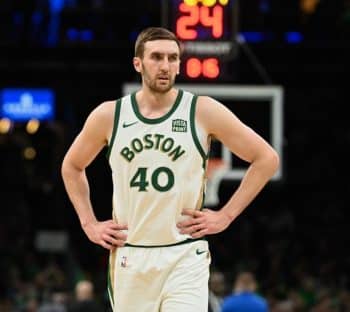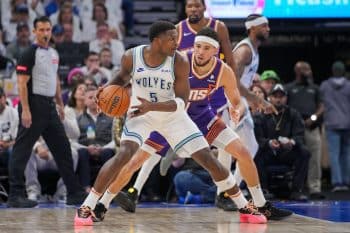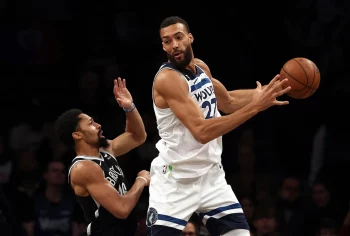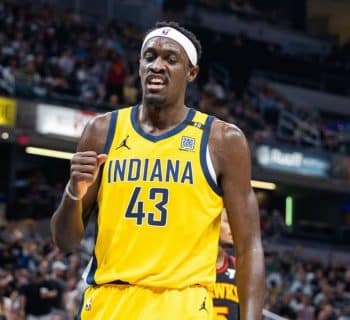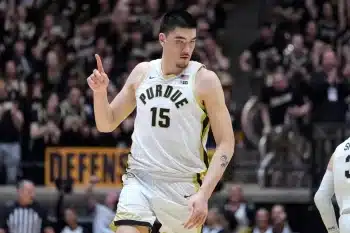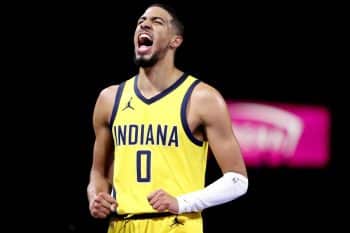NBA
Six Things to Know About the Golden State Warriors

The Golden State Warriors were the darlings of the first two playoff rounds in 2013 before finally succumbing to the San Antonio Spurs in six games. After a blockbuster offseason brought swingman Andre Iguodala from the vanquished Denver Nuggets, the Warriors looked poised to move into the league’s elite. At times the team has looked that way, especially when their dominating starting unit plays together. Other times, the team has played .500 ball. As the season moves towards the All-Star break, here are six things you need to know about the Golden State Warriors.
David Lee’s Defense Isn’t So Bad Anymore
The 2013 Sloan Sports Analytics Conference saw Lee became the poster child for terrible interior defense courtesy of research by Grantland’s Kirk Goldsberry, which showed that teams made an inordinate number of shots when Lee was defending near the rim. Shortly thereafter, Lee essentially missed the Warriors’ surprise 2013 playoff run after tearing a hip flexor in Game 1 against the Denver Nuggets. After this success sans Lee, many posited that the Warriors would be better off playing a four-out style with a three-point shooter like Harrison Barnes or Draymond Green at power forward.
Lee apparently took the criticism of his defense to heart, losing five percent body fat in the offseason and getting into better cardiovascular shape. This was sorely needed; Lee’s biggest problem in recent years had been sustaining multiple efforts and getting into the right position on defense. His hard work has paid off, as the Warriors allow only 98.9 points per 100 possessions with him on the court.* This year, Lee has allowed 49.1 percent shooting while defending the rim, a massive decrease from last year’s 61 percent as noted by Goldsberry. Indeed, that number ranks a very respectable 21st in the league out of 61 players who defend four or more shots per game at the rim. Subjectively, his pick and roll defense and rotations have improved mightily over past years. Lee has even displayed stout post defense of late, forcing LaMarcus Aldridge into a miserable 2-14 shooting night and even doing well against the powerful Blake Griffin during the times they were matched up on Thursday.
*In fairness, most of the credit for this solid number should go to defensive stalwarts Andre Iguodala and Andrew Bogut, with whom Lee shares most of his minutes. But at the very least it can be said that Lee is not preventing the Warriors from defending well, which could not be said in past years.
Lee will never possess the imposing physical gifts of the best interior defenders. He remains a liability at times due to his below average weight, length, and two foot jumping ability compared to many power forwards. He is still prone to getting bludgeoned in the post at times, his defensive rebounding has been below average,* and he has blocked 16 shots all year. These problems are compounded when he is forced to play center with some of Golden State’s bench units, or when coach Mark Jackson has benched Andrew Bogut late in games.
*Especially at the end of games or when he has to box out centers on free throws.
But despite these warts, Lee’s failings are now largely the result of his physical limitations instead of a lack of effort, awareness or conditioning. In 2013-14, Lee competes as hard as he needs to and is now close to maximizing his limited defensive potential.
The Warriors Are Most Likely to Be the Sixth Seed
Predicting a Warriors playoff berth does not exactly go against the grain of conventional wisdom, but after a recent spate of home losses to the Nuggets, Pacers, Timberwolves and Wizards took the shine off a franchise-best East Coast road trip it suddenly appeared as if their assumed playoff position might be vulnerable. But recent events have bolstered the Dubs’ chances to a near certainty. The Warriors righted the ship with back to back wins against the Clippers and Jazz. But perhaps more importantly, the surging Grizzlies (Mike Conley) and Wolves (Nikola Pekovic) suffered ankle injuries to one of their top two players that should have them both out a week and potentially longer. Meanwhile, Dallas does not appear to have the personnel on defense to make a significant move. All of the aforementioned competition is at least 2 games back in the standings.
The Warriors are in seventh position in the conference, in a virtual tie with Phoenix for sixth. Mark Jackson’s squad has a better point differential than the Suns, and Eric Bledsoe should still be out for a while. The Warriors seem likely to pass the Suns, pending any potential trades by Phoenix.
At 3.5 games behind the Clippers for the fourth seed, Golden State is unlikely to seize homecourt advantage in the first round. But getting at least the sixth seed is paramount for the Warriors. This would allow them to avoid a first round matchup as a heavy underdog against likely one and two seeds Oklahoma City and San Antonio. Instead, the likely opponent would be Portland or the Clippers, both of which the Warriors would stand a decent chance of beating. In fact, with little difference between those two potential opponents (at least at this juncture), the sixth seed might serve the Warriors better than the fifth seed, currently held by the Rockets. This would allow them to avoid a matchup against first-seeded Oklahoma City until the conference finals. As proven in last year’s playoffs before Bogut and Stephen Curry were injured, the Warriors matchup reasonably well with projected second seed San Antonio, though they would still be an underdog in a series against a healthy Spurs team.
The Warriors Need Klay Thompson to Diversify His Game
The 11th overall pick in the 2011 draft is a great three-point shooter and solid defender. Those two things alone make him a valuable player. The problem is that those two things are alone—he does virtually nothing else well. The Washington State product is 30th among shooting guards in PER due to his lack of rebounds, assists, steals and free throws. The Warriors rank a disappointing 16th offensively by points per possession, a very poor result for a team featuring the Mark Jackson-christened best shooting backcourt in NBA history.
Part of the problem is how one-dimensional Thompson is on offense. Passing is a particularly neglected aspect of his game. Thompson is one of the worst and least frequent passers among the league’s guards. His assists per 36 minutes ranks 50th among the 54 guards who have qualified for the minutes leaderboard and have a usage rate above the league average of 20 percent. Moreover, he averages a mere 20 passes per game in his 38 minutes per game. How bad is that? Among the 116 players at all positions who play 30 minutes per game or more, Thompson ranks 116th in passes per game.
This is not to imply that Thompson is selfish or takes an inordinate number of bad shots. His role is to shoot the ball. At 41 percent from deep, pretty much any shot he takes out there is a good one. And while his True Shooting Percentage is disappointingly near the league’s average due to his propensity to take long twos and inability to get to the line,* he is not mindlessly gunning away. But, the only way Thompson helps the Warriors’ offense is by shooting from the outside. That certainly has value outside of the box score statistics, as his man must remain glued to him at all times. Unfortunately, his offensive impact is limited because he is not a passing threat when he does try to create on his own, whether off a close out or postups.
*Thompson might be well-served to watch tape of guys like Reggie Miller and Richard Hamilton, two players who got to the line at solid rates despite their jumpshot-based games. However, emulating them may not be possible since Thompson lacks the athleticism of even those players.
As a third year player, Thompson will be eligible for an extension to his rookie contract this offseason. The negotiations will be fascinating, as there are many conflicting indicators on his value.
The Warriors Cannot Create Without Curry
A season-long problem for the Dubs has been their putrid offense without Curry on the floor. With him, they score 108.8 points/100; without him that drops to 89.7. The former rate would nearly lead the league, the latter is far below the worst team in the league. Why are they so bad without Curry? He is their only real offensive creator. He ranks in the 84th percentile in points per possession out of the pick and roll. Thompson ranks second on the team at the 40th percentile, but as discussed he cannot create for others. The rest of their perimeter players, namely Harrison Barnes (22nd percentile), Andre Iguodala (6th) and Jordan Crawford (3rd), are even worse.* Until the Warriors can find someone else to create offense out of basketball’s most basic play, they will continue to struggle without Curry on the floor.
*Crawford was brought in to upgrade the shot creation on the second unit, and he has—departed point guard Toney Douglas was only in the 2nd percentile out of the pick and roll.
Andre Iguodala is Essential to the Defense
Andrew Bogut has gotten the most buzz as the key to the Warriors’ defense, and his rim protection and defensive rebounding have been fantastic in his first healthy season in several years. Nonetheless, Andre Iguodala has the most impressive on/off court numbers on that end. With Iguodala in the game, the Warriors allow a mere 95.8 points/100, which would rank second in the league. Without him, the D falls to below league average at 103.7 points/100. Subjectively, Iguodala has not appeared to be the individual stopper he once was, especially upon returning from his hamstring injury. However, his team defense is still outstanding, especially against teams without a dominant wing. He was all over the floor in recent home victories when the Dubs shut down the elite Portland and Clippers offenses.
Get Used to This Team
For better or for worse, this Warriors starting five will likely be in town for quite a while. Curry is in the first year of a 4-year, $44 million contract extension that may be the best value non-rookie contract in the league. Bogut just signed a 3-year, $36 million extension that kicks in next season. Iguodala is in the first year of a 4-year, $48 million deal he signed as a free agent over the summer. And Lee still has 2 years and $30.5 million remaining after this year on the 6-year, $79.5 million contract signed in the summer of 2010. Meanwhile, Thompson is under team control for at least another year, and the Warriors can match any offer to him as a restricted free agent in the summer of 2015 if they fail to agree on an extension this offseason. Finally, the Warriors gave up 2014 and 2017 first round picks to Utah to help clear salary for the Iguodala signing, so they are prohibited from trading any first rounders aside from their 2019 selection.
In my recent interview with him, General Manager Bob Myers intimated that the Warriors still have flexibility to add to the roster. I must respectfully disagree. The Warriors really have no major trade chips left aside from Thompson and Harrison Barnes, who has fallen short of the high expectations many (though not your writer) had for him in his second year. Dealing Thompson would leave the Warriors with a giant hole at shooting guard, so that seems unlikely. That would leave a potential trade of Barnes’ perceived upside for a legitimate third big man or a more established wing scorer. It is unclear how much value Barnes still has around the league, but one would imagine the Warriors will simply hold onto him and hope he can evolve into the fourth scorer this team desperately needs right now.
With no salary cap space, few tradeable assets, no 2014 first-rounder and big long-term contracts for their key players, this is likely the Warriors’ team for at least the next two seasons.
